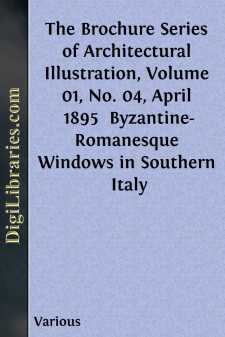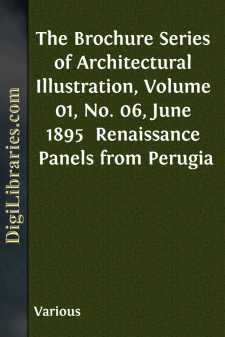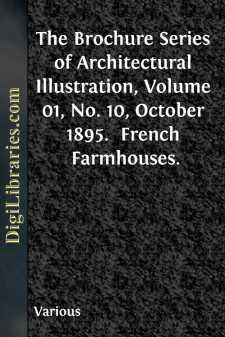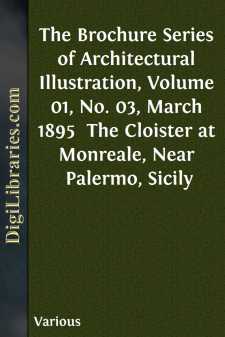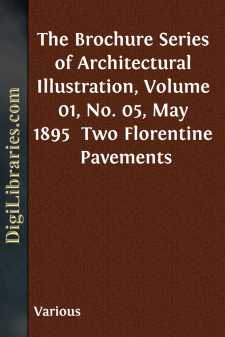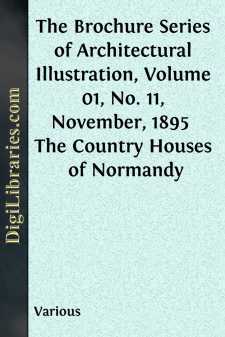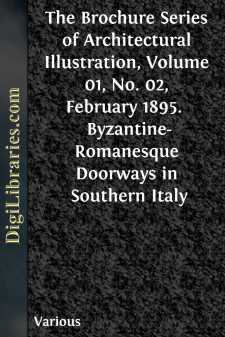Periodicals
- Art 27
- Children's periodicals 59
- Entertainment 5
- Food/Wine 2
- Games/Humor 455
- General 661
- Health 1
- History 53
- House/Home 1
- Regional 62
- Science/Nature 118
- Transportation 10
Periodicals Books
Sort by:
by:
Various
BYZANTINE-ROMANESQUE WINDOWS IN SOUTHERN ITALY. The collection of photographs from which the plates in this and the February number were selected was only recently made under the direction of Signor Boni, an official of the Italian government, charged with the care and restoration of historic monuments. The province of Apulia has been so little invaded by the march of modern improvement, and its...
more...
by:
Various
r Wilson Eyre, Jr., in an article in The Architectural Review for January, which has been alluded to in our issue for October, and from which we have borrowed the three charming illustrations reproduced from his drawings, speaks as follows of English domestic architecture: “There is much to be seen from the railroad in the way of long rambling farmhouses and country houses of the modest kind, and...
more...
by:
Various
I. SOUTHWEST ANGLE OF THE DUCAL PALACE, VENICE. Although the Ducal Palace is much larger than the other palaces of Venice, and intended for general civic uses as well as a residence for the Duke or Doge, it follows closely the type already described. It has undergone so many changes since its first foundation in about the year 800 (813 according to Ruskin), having been destroyed five times, and as...
more...
by:
Various
RENAISSANCE PANELS FROM PERUGIA. The carved walnut panels from the choir stalls of the Church of San Pietro de' Casinense in Perugia, designed by Stefano da Bergamo in 1535, which are given as illustrations in this number, are excellent examples of the ornament of the later period of the Italian Renaissance. This form of ornament was first used in flat painted panels upon pilasters, such as the...
more...
by:
Various
FRENCH FARMHOUSES. As it is the purpose of THE BROCHURE SERIES to cover as wide a field as possible in choice of subject matter for its illustrations, and at the same time hold rigidly to the idea of furnishing only what will be useful to its subscribers, it has seemed desirable to present something a little nearer our everyday life than the Italian work which has thus far formed the greater part of...
more...
by:
Various
THE CLOISTER AT MONREALE, NEAR PALERMO, SICILY. The island of Sicily, being in form nearly an equilateral triangle, with one side facing towards Italy, another towards Greece, and the third, towards Africa, was a tempting field for conquest to the various nations surrounding it. It was successively overrun by the Greeks, Carthaginians, and Romans, and later, after the Christian era, again successively...
more...
by:
Various
TWO FLORENTINE PAVEMENTS. The church of San Miniato al Monte, just outside the walls southeast of Florence, and the Baptistery, or church of San Giovanni Battista, in Florence, are among the finest examples of the Tuscan Romanesque style, and both probably date from about the same time—the early part of the twelfth century—although the date of San Miniato has until recently been referred several...
more...
by:
Various
ITALIAN WROUGHT IRON. The wrought iron of the middle ages, and of the time of the Renaissance, and even down to the last century, in Italy, France, and Germany showed, in the crudest examples, the principal virtues of all true decorative art. The reason is not far to seek. The difficulties in the way of working the material with ease imposed certain limitations in design and execution which could not...
more...
by:
Various
THE COUNTRY HOUSES OF NORMANDY. THE houses chosen for illustration in this number are of different types, of different dates, built for men of different stations in life, and are constructed of different materials. They are, however, all in the province of Normandy, in northern France, and they are all situated outside the towns; further than this it may not be well to go in attempting to classify them...
more...
by:
Various
BYZANTINE-ROMANESQUE DOORWAYS IN SOUTHERN ITALY. The illustrations chosen for this issue are all from the Byzantine Romanesque work in the province of Apulia, that portion of Southern Italy familiar in school-boy memory as the heel of the boot. Writers upon architecture have found it difficult to strictly classify the buildings of this neighborhood, as in fact is the case with most of the medieval...
more...


